It was a nice cool night in the wooded Ecopark. A canal water stream rushed down the mountain beside our camper. There is a diversion for irrigation and also to an old power plant where I could see 2 generators through the window. It is no longer in use. The drive into Cochabamba took longer than expected. It was one straight road with the usual bus stops in front of your nose, but was very busy. It looks like the long valley which used to be the vegetable provider of the miners in Potosi is now completely built up with one town/suburb after another. We were lucky to find a street parking for our camper bus and went to explore the town centre. The streets were busy and around lunch time we dropped into a small modern fast food place and observed the people wandering by. Most of them were mestizos (from Spanish descent) and not so much natives like for example in La Paz. We were waiting till the siesta was over so we could visit the Convent de Santa Teresa. After 2 hours of waiting and walking around the convent, we found an open door where somebody told us that the convent was closed till 16/4. (Renovation??) Bummer. We got in the camper and drove through a maze of streets and diversions to the Palacio Portales. This is one of the 2 small palaces (1927), the rich tin Baron Simon Portales built in this valley. First palace was next to our previous campsite. We drove all around the walls of the large garden only to be told that it was only open for one hour at 15:00 hrs. The one in town also only opened at 16:00. We took the Spanish tour through the palace and gardens. I cannot share here the lovely painted walls and sculptured fireplaces because we were not allowed to take pictures inside the house.
We left town to go to Sucre. The Garmin sent us via the more northerly RN 4 which was packed with trucks slugging up the mountain to go to Santa Cruz. After 60 km we finally could take a small road crossing down to the RN 7 to Sucre. Since it gets dark early, we had to stop and actually found our first free camping site along a river stream which was not in iOverlander. We immediately added it to the database.
We took this route because some 25 km off the RN 7 there is one of the most Southernly Inca ruins. It was a fortress/administration center (1460) which did not function that long before the Inca empire collapsed due to the Spanish invasion. The winding road through a valley and up a mountain was covered with cobblestones. At the start you had to pay toll (1 bol, 0,12 Euro) to use it. The old man than lowered the rope to let you through. Along the way we heard again a familiar banging from underneath the car. Fortunately it was not the front torsion bar connection but the right rear shock absorber which had broken lose. Because we had experienced this before (on the left side) there was no great panic as we knew how to repair it and by carefully driving on would not be a problem.
The ruins were extensive. In front of a flat plaza, is a very large building (Kallanka, 80×25 m) which used to be covered. On one side the building had door openings and windows and on the other side niches in the wall where, like in the Omanis forts. You could store your belongings. There are many more remains of other buildings, grain silos and also there is a waterfall for the water supply. A well worth detour especially since we did not get to see much Inca ruins in Isla del Sol.
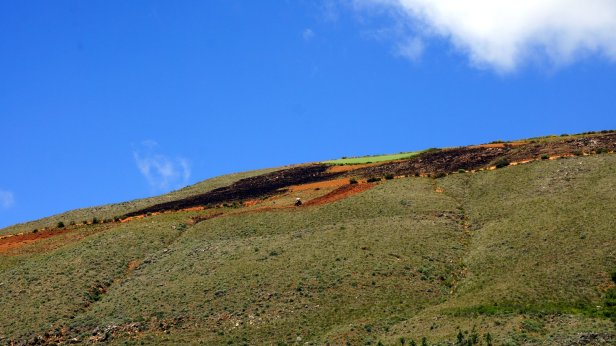
The rest of the road to Sucre is also covered with rows of cobblestones. It was a lovely drive over the mountains and down the valleys. There are hardly any towns or houses along the way despite that the area looked fertile. Again we could not reach the objective before sunset, so we camped by a river some 140 km before Sucre. Locals were washing the car in the river so Jamaliah got inspired and did the same while Rudy lay down in the river stream and washed himself.
Some 5 km before Sucre, we stopped at Parque Cretacio. The mountain was being mined in order to make Cement. Because the quality of the rock (increase of Magnesium) was deteriorating, mining had stopped and after rain/wind cleaned up the vertical layer of rock, thousands of footprints became visible. There were made in the mud some 65 million years ago by several types of dinosaurs who walked over the mud to the lake shore. The museum is well funded and has several replicas of the animals which left behind the foot prints. Bones were not found but those we had seen in Argentina. The noon tour we took was very informative and in this way we could get closer to the footprints.
The first task in Sucre was to get the car fixed. We only knew of a English speaking mechanic in a motorcycle shop. Obviously he could not fix our problem but was so kind to lead us in his motorbike through the narrow and steep streets of Sucre to a workshop which could weld our shock absorber. In the end it was not welding on a new thread but making a new thread in the remaining body which did the trick. When all was done and I was about to pay and leave, the mechanic pointed out that my spare tire rack, which is glued and bolted on to the back of the camper was letting loose. This was a shock because if that comes off, it can be a show stopper for the rest of the trip. One of the bolts was loose and could not be tightened again. A slightly thicker bolt was found and the construction was again screwed tight to the camper. Some 2 components glue was added for extra safety.
After driving through a maze of streets, we found our next campsite which is hidden from the road by a big steel door. Behind is a small grass field with a dining and a bathroom/shower chalet. Perfect. To our surprise the area was full with other overlanders but we could still fit in. There were 2 Swiss Toyota 4×4, and 2 Dutch Overlanders. (Eric & Evelyn and Ralph & Janneke, “Dutch On Wheels”). This was a great surprise because up till now, we had not meet any Dutch Overlanders. We had a great evening sitting around the folding tables and swapping travel experiences. Both couples have been traveling longer than us (6 months and 2 years respectively) so we gathered a lot of information on the roads ahead.
On Saturday 7/4 we wandered into town. The narrow streets are full of cars and buses as well as the narrow sidewalks full of people. The houses are primarily whitewashed in the city centre. After visiting the San Francisco church and the Cathedral, it was already siesta time so we wandered a bit around and had lunch in a small food court on the way up the mountain towards our next objective, “Museo del arte Indigena”. For 3 Euro we had one bowl of a mixture of potatoes and very large corn with some large pieces of boiled meat and a large jug of juice made from local fruits.
While waiting for the museum to open we waited underneath an arcade with a lovely view of Sucre below. Apparently this is the place for wedding pictures because the couples we saw getting married earlier in the cathedral were here for the photo shoot too and also another just married couple.
The museum showed historical and modern textiles. The weavings are very intricate and show visions of animals and humans. These art of weaving is having a revival in this area and the shop has some lovely examples for sale. We bought a relatively simple table cloth as a memento.
In the evening we had a Dutch food party at the campsite. Hete bliksem, (Carrots & Onion) and Broccoli stamppot were made topped up with gehakt bal and freshly made applemoes. The Swiss joined in on the party. This was a great round off to our stay in Sucre. The next day (late) we packed up, said our farewells and drove to Potosi (134 km, 4000 m).
Potosi (1545) and at 4100m height, is even older than Sucre. It is for some 300 years the main source of silver in the world. Next to the town is a large mountain which was literally full of silver. It financed the Spanish wars against the Dutch (and others) till peace was achieved after 80 years in 1648. Work in the underground mine is still ongoing (for lead and zinc) albeit at a smaller scale than before. Still the work is dangerous and the miners do not get very old as a result of Silicosis. Rudy has booked himself an underground tour for tomorrow.
The town of Potosi on a Sunday is very quiet. Mostly it is only buses slugging up and down the narrow steep streets. Because of its age and past wealth there are a lot of lovely old buildings along the streets and around the plazas. It is a vast contrast with the busy streets of Sucre. Some houses have wooden balconies hanging over the street. They remind us of New Orleans. From everywhere in town you see the “silver “mountain leaning over the city like the mountain of doom.





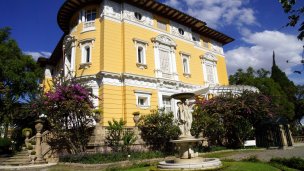

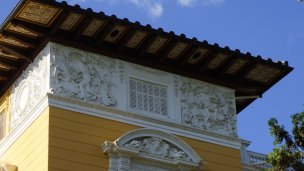





























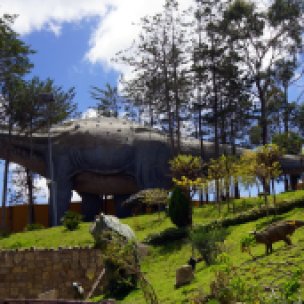

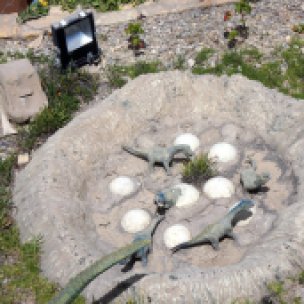





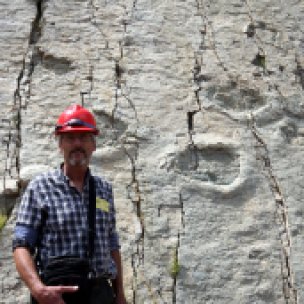








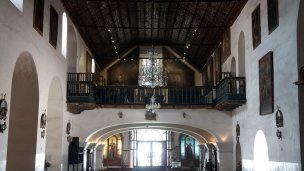


















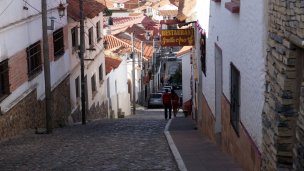





































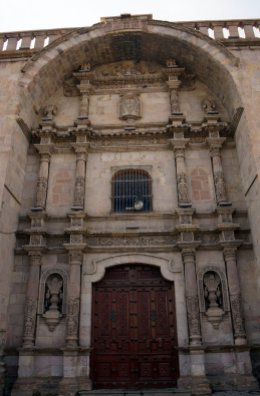







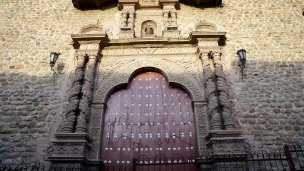

Wat een fantastische reis maken jullie toch en Passe-Partout houdt zich geweldig op wat kleine dingetjes na. We genieten van jullie verhalen en de prachtige foto’s! Ik kan me ook voorstellen hoe leuk het is om daar dan Nederlanders tegen te komen en dan Hollandse gerechten te maken.
Ruud en Jamaliah, goede reis verder en we kijken uit naar jullie volgende verhaal.
Groetjes,
Ton en Elly
LikeLike